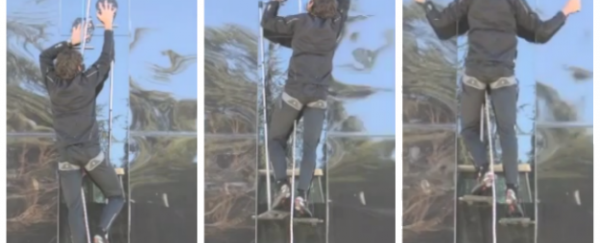Engineers in the US have invented a new gecko-inspired climbing technology that enables a human to scale a glass wall using two large adhesive pads.
Gecko toes have garnered a lot of attention from engineers in the past, because they allow these little reptiles to stick to any surface without the use of an adhesive substance. Unlike snails, that support themselves using a thick, sticky goo, geckos stick to surfaces because their toes are covered in rows of tiny microscopic hairs called setae, and each seta is made up of clusters of even tinier hairs.
When these clusters get close to a surface, a physical bond called the van der Waals force takes over. This bond occurs when electrons from the tiny hair molecules interact with electrons from molecules of the surface - such as a wall or a ceiling - and produce an electromagnetic attraction. They can even stick and unstick their toes by changing the angles of the hairs, which allows them to scamper across a ceiling at speeds of up to 20 body lengths per second.
While the Stanford climbing system is by no means that fast yet, it works using the same principals. Led by engineer Mark Cutkosky, the team made tiles of silicon pads covered in tiny ridges made from a polymer material called PDMS, and then attached them to hexagonal hand-pads. "Each gripper was backed with a spring that distributed weight across the pad, and absorbed some of the force involved in climbing," says Katherine Bourzac at MIT's Technology Review. "To make climbing easier, the researchers also linked the grippers to platforms for a person's feet, thereby transferring the work of climbing to the legs."
The team is now working with NASA's Jet Propulsion Laboratory in the hopes of creating adhesive pads for robots to use when exploring the Universe, and would like to adapt the technology to create moveable solar panels.
They also need to figure out how to improve their device for dusty, dirty surfaces. "The synthetic adhesion system may be able to outperform a gecko on relatively flat, smooth and clean vertical glass, on other surfaces, it has poor performance compared with the gecko," Cutkosky told Richard Gray at The Guardian.
"On contaminated surfaces, even geckos have trouble producing adhesion. The PDMS microwedge adhesive can be cleaned between steps by touching a material of higher surface energy like sticky tape and it may be possible to achieve self-cleaning," he said.
The team published the findings in the Journal of the Royal Society Interface.
Sources: Technology Review, The Guardian
